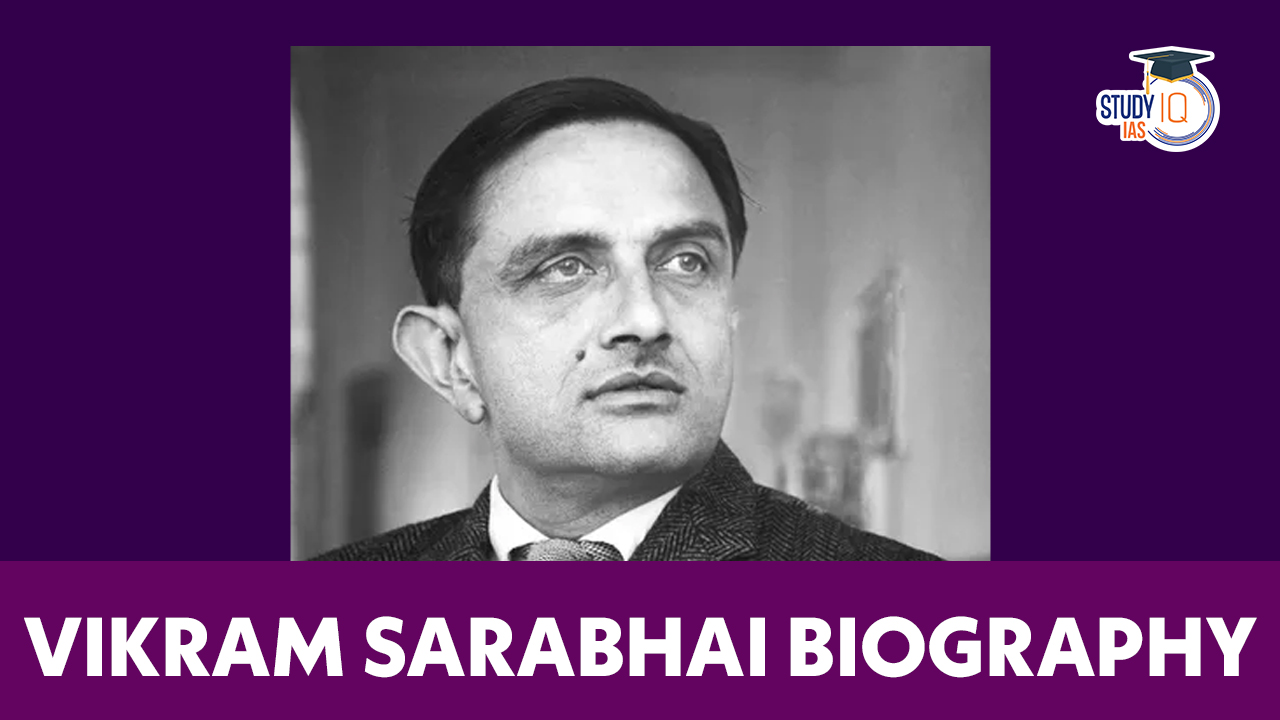Table of Contents
Vikram Sarabhai
Vikram Sarabhai, an eminent scientist, visionary, and the founding father of the Indian space program, left an indelible mark on the world of science and technology. His unwavering dedication, pioneering vision, and relentless efforts have played a pivotal role in shaping India’s journey into space exploration. This article explores the life, achievements, and legacy of Vikram Sarabhai, highlighting his contributions to space research and technology.
Who is Vikram Sarabhai?
Vikram Sarabhai (12 August 1919 – 30 December 1971) was one of the greatest scientists in India. He is renowned as the Father of the Indian space program, encompassing roles of a scientist, innovator, industrialist, and visionary. His contributions extended to establishing the Physical Research Laboratory (PRL) and chairing the Atomic Energy Commission.
Alongside fellow Ahmedabad-based industrialists, he was pivotal in founding the Indian Institute of Management, Ahmedabad. A prolific institution builder, he founded or aided in creating an impressive 42 institutes spanning fields like Science, Industry, Management, and Education. Instrumental in forming the Indian Space Research Organization (ISRO), his legacy resonates through his multifaceted accomplishments.
Read about: Sarojini Naidu
Vikram Sarabhai Education and Early Life
Vikram Sarabhai emerged into the world as one of eight siblings in a privileged family of forward-thinking industrialists. His early schooling transpired within the nurturing corridors of “Retreat,” a private Montessori institution founded and guided by his parents. Set against the backdrop of a politically charged environment, he grew up amid India’s elite, instrumental in securing the nation’s independence and subsequently orchestrating its inaugural governments. This immersive upbringing acquainted him with notable figures, including interactions with Congress Party stalwarts like Jawaharlal Nehru. His familial network extended to spirited activism—his mother, Sarladevi, championed social causes and Montessori education, while his sister ventured into political activism. His aunt, Ansuyaken, emerged as a leader in the national labor movement.
Having completed his studies at Gujarat College in Ahmedabad in 1937, Vikram embarked on a journey to England for advanced education. He matriculated at the venerable St. John’s College, University of Cambridge, culminating in the attainment of the Tripos in Natural Sciences in 1939. As the shadows of World War II loomed, he returned to India, enrolling at the Indian Institute of Science in Bangalore. Under the sagacious guidance of the esteemed scientist C.V. Raman, he delved into pioneering research on cosmic rays, ultimately authoring his inaugural scientific publication, “Time Distribution of Cosmic Rays,” in 1942.
In 1942, he entered into matrimonial union with the renowned classical dancer, Mrinalini. Their partnership flourished, yielding two offspring who, in time, would carve their own niches in the world of prominence. Noteworthy among them, his daughter Mallika and son Karthikeya emerged as accomplished individuals in their own right. Intriguingly, his spouse, Mrinalini Sarabhai, bore a kinship with India’s freedom fighter and revolutionary, Dr. Laxmi Sahgal. The Sarabhai clan’s leisure pursuits often led them to the tranquil embrace of the Himalayas. Here, Vikram astutely recognized the fertile grounds high altitudes provided for the study of cosmic rays, a realization that led to his strategic deployment of cosmic ray counters during these sojourns.
It was amidst the sublime landscapes of Gulmarg, near Alpathari Lake, in 1943 that Vikram’s aspirations coalesced into a visionary concept—a dedicated laboratory focused on cosmic and atmospheric physics. A return to Cambridge in 1945 further honed his expertise in cosmic ray investigations, culminating in the conferment of his doctoral degree for his scholarly dissertation, “Cosmic Ray Investigations in Tropical Latitudes.”
His influence radiated across geographical boundaries. During a visit to Thiruvananthapuram, he participated in the foundation stone laying ceremony of the Thumba railway station, a critical component supporting the newly established Thumba Equatorial Rocket Launching Station.
Read about: Bhagat Singh
Vikram Sarabhai Birth Anniversary and Legacy
Every year on August 12th, India celebrates the birth anniversary of Vikram Sarabhai as National Science Day. This day serves as a reminder of his enduring legacy and his significant role in propelling India’s technological advancement. Sarabhai’s unparalleled vision prompted the establishment of several research institutions, with the Vikram Sarabhai Space Centre (VSSC) being a standout accomplishment.
Read about: Subhash Chandra Bose
Vikram Sarabhai: Contributions and Inventions
Upon his return to India in the post-independence era, Vikram Sarabhai keenly perceived the dearth of robust scientific infrastructure. Harnessing the influence of the charitable trusts under his family’s stewardship, he orchestrated the establishment of pivotal institutions that would redefine India’s scientific landscape.
Notably, in November 1947, Sarabhai played a pivotal role in birthing the Physical Research Laboratory (PRL) in Ahmedabad. With atmospheric scientist K.R. Ramanathan as its founding director, PRL evolved into a distinguished research institution specializing in cosmic rays and space sciences. The foundation was laid within the confines of M.G. Science Institute, an educational bastion his parents had founded. Bolstered by support from the Council of Scientific and Industrial Research (CSIR) and the Department of Atomic Energy, PRL burgeoned into a scientific powerhouse.
The pivotal juncture of 1957-1958 marked the International Geophysical Year (IGY), a turning point that exposed Sarabhai to the uncharted domain of space science following the launch of Sputnik-I. Galvanized by this, the Indian National Committee for Space Research emerged, with Vikram Sarabhai at its helm. His strategic initiatives extended to education, notably as the founding director of the Indian Institute of Management (IIM), Ahmedabad, which he co-pioneered with businessman Kasturbhai Lalbhai in 1961. Another pioneering endeavor was the creation of the Centre for Environmental Planning and Technology University (CEPT University) in 1962, enriching disciplines such as architecture, planning, and technology.
The 1960s were marked by the establishment of key institutions driven by Sarabhai’s vision. The Vikram A. Sarabhai Community Science Centre (VASCSC) was forged to ignite scientific and mathematical interest among students and the public. Meanwhile, the Nehru Foundation for Development (NFD), established in 1965, was dedicated to probing societal and individual development concerns.
An invaluable collaborator was Dr. Homi Bhabha, a luminary in nuclear research. Together, they propelled the launch of India’s first Rocket Launching station (TERLS) at Thumba, strategically located near the equator on the Arabian Coast. The inaugural rocket, bearing a sodium vapor payload, soared on November 21, 1963. Recognition soon followed, with the UN General Assembly acknowledging TERLS as an international facility.
Tragedy struck in 1966 with the untimely demise of Homi Bhabha, leading to Sarabhai’s appointment as Chairman of the Atomic Energy Commission. Yet, his most enduring contribution materialized in 1969—the Indian Space Research Organization (ISRO). This entity, born of his vision, aimed to advance space technology for national betterment. Sarabhai’s multifaceted impact extended to sectors beyond science, with initiatives such as the Ahmadabad Textiles Industrial Research Association (ATIRA), empowering the textiles industry. He continued this legacy of empowerment through endeavors like the Blind Men Association (BMA), providing essential support to the visually challenged.
Moreover, in tandem with his wife, Mrinalini Sarabhai, he seeded the inception of the Darpana Academy of Performing Arts. The imprint of his visionary prowess extended to institutions of note including the Faster Breeder Test Reactor (FBTR), Variable Energy Cyclotron Project, Electronics Corporation of India Limited (ECIL), and Uranium Corporation of India Limited (UCIL).
The culmination of his dialogue with NASA in 1966 was the launch of the Satellite Instructional Television Experiment (SITE) in 1975-1976, a legacy that persisted even after his passing.
|
Institutes established by Vikram Sarabhai |
|
Read about: Maharana Pratap
Vikram Sarabhai Space Centre (VSSC)
The Vikram Sarabhai Space Centre, founded in 1963, stands as a testament to Sarabhai’s dedication to advancing space technology in India. Located in Thiruvananthapuram, Kerala, VSSC has been instrumental in developing indigenous rockets and launch vehicles. Under his leadership, India’s first satellite, Aryabhata, was launched in 1975, marking a historic milestone in the country’s space endeavors.
Incorporating state-of-the-art facilities and a cadre of brilliant minds, VSSC nurtures a culture of innovation and exploration. Its endeavours encompass conceptualizing, designing, and validating space systems, all of which form the bedrock of India’s space accomplishments. Significantly, VSSC has been a key player in the design and advancement of launch vehicles such as the Polar Satellite Launch Vehicle (PSLV) and the Geosynchronous Satellite Launch Vehicle (GSLV). These achievements have empowered India to effectively launch satellites dedicated to communication, navigation, earth observation, and scientific investigation.
Dr. Vikram Sarabhai’s indomitable spirit is woven into the very fabric of VSSC, infusing it with a relentless pursuit of excellence and a commitment to serving national and global interests through space exploration. As a beacon of scientific innovation, VSSC continues to shape India’s space journey, ever-advancing the frontiers of human knowledge and technology, and exemplifying the profound impact of visionary leadership and dedicated pursuit of the unknown.
Read about: Chandra Shekhar Azad
Vikram Sarabhai: Awards & Achievements
- President, Physics Section, Indian Science Congress (1962): Showcased his stature in the scientific community and commitment to advancing knowledge.
- Vice-President, Fourth U.N. Conference on ‘Peaceful Uses of Atomic Energy’ (1971): Exhibited his global influence in peaceful nuclear technology.
- President, General Conference of the I.A.E.A., Vienna (1970): Underlined his significant contributions to global atomic energy cooperation.
- Vikram Sarabhai Space Centre (VSSC): A tribute to his role in shaping India’s space program, this center remains a hub for pioneering rocket propulsion research.
- Sarabhai Crater: Honored by the International Astronomical Union with a crater on the moon, cementing his legacy in space exploration.
- Shanti Swarup Bhatnagar Award (1962): Recognized for his pioneering cosmic ray research and space science contributions.
- Padma Bhushan (1966): One of India’s highest civilian honors, acknowledging his multidimensional impact on science, education, and society.
- Posthumous Padma Vibhushan (1972): Enshrined him as a visionary leader and scientific luminary in India’s history.
Read about: Mangal Pandey
Vikram Sarabhai: Passing and Legacy
Tragically, Vikram Sarabhai’s journey was prematurely curtailed as he breathed his last on December 30, 1971, at the age of 52, succumbing to a cardiac attack. His sudden departure was an irreplaceable void in the scientific realm, yet his enduring legacy persevered through the institutions he founded and the frameworks he set in motion. His pioneering notion of leveraging space technology for societal progress continues to illuminate ISRO’s path, propelling India into a commanding stature within the international space domain.
Information about Vikram Sarabhai
Dr. Sarabhai, who is regarded as the founder of the Indian space programme, was a brilliant institution-builder who founded or assisted in the establishment of numerous institutions across a wide range of areas. After returning from Cambridge to an independent India in 1947, he encouraged philanthropic trusts run by his family and friends to endow a research facility close to home in Ahmedabad, which is how the Physical Research Laboratory (PRL) came to be.
Thus, Vikram Sarabhai founded the Physical Research Laboratory (PRL) in Ahmedabad on November 11, 1947. He was only 28 at that time. Sarabhai was a creator and cultivator of institutions and PRL was the first step in that direction. Vikram Sarabhai served of PRL from 1966-1971.
Read about: Bal Gangadhar Tilak
Vikram Sarabhai UPSC
Vikram Sarabhai’s life and work continue to inspire generations of scientists, researchers, and visionaries. His pioneering efforts, coupled with his dedication to using science and technology for the betterment of society, have left an indelible mark on India’s space program. Through his visionary leadership, he ignited the spark that has propelled India’s journey into space exploration, turning his dreams into reality and laying the foundation for a brighter technological future.
Read about: APJ Abdul Kalam


 TALASH Initiative: Objective, Key Featur...
TALASH Initiative: Objective, Key Featur...
 Custodial Deaths in India, Types, Issues...
Custodial Deaths in India, Types, Issues...
 MPPSC FSO Recruitment Notification 2025 ...
MPPSC FSO Recruitment Notification 2025 ...





















